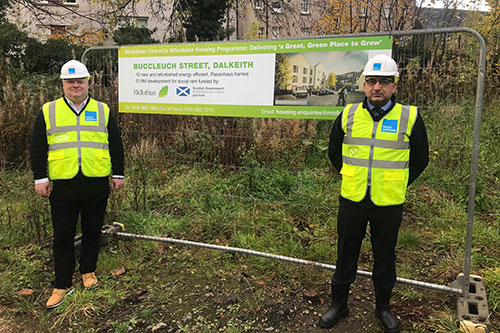Thursday February 3rd 2022

Pictured are Midlothian's Cabinet Member for Housing Cllr Stephen Curran (left) and Brian Pettigrew (right), Director of contractor Morris & Spottiswood at the site of where the new Passivhaus homes are underway in Dalkeith.
The most ambitious Passivhaus affordable housing programme in Scotland is underway in Midlothian.
Midlothian Council is paving the way by building 182 green council homes of the future. All of them will meet the demanding energy-efficient building ‘Passivhaus’ standard.
Cabinet Member for Housing Cllr Stephen Curran said:
“I am very proud to say Midlothian Council is at the forefront of making sure our council tenants can live in affordable, warm and energy efficient homes, which is good news for them – especially as we are all facing soaring utility bills – while helping us towards our ambition of being a carbon neutral council by 2030.”
Six homes are already being built to the standard at Buccleuch St in Dalkeith.
A further 46 homes with extra care are to be built at Polton Street, Bonnyrigg; 20 homes are planned at Burnbrae in Bonnyrigg; 20 more Passivhaus homes will be on Bonnyrigg High Street and further work will begin on 90 homes on the site of the former Newbattle High School in Easthouses. All of these homes will be council homes for social rent.
This project is the largest Passivhaus development programme in Scotland.
Building homes to this green energy standard is a key element of Midlothian Council’s route to Net Zero by 2030.
Professor Sean Smith, director of the Centre for Future Infrastructure at the University of Edinburgh’s Edinburgh Futures Institute said:
“Building to Passivhaus standard for our new homes supports the step change towards lower energy bills, improved comfort all year round and contributes towards reducing emissions to address climate change. Importantly it provides a pathway for Midlothian to underpin Scotland’s growth in the green economy and jobs whilst supporting an inclusive community approach.”
The Passivhaus standard was developed by the Passivhaus Institute in Germany. The standard sets out stringent requirements that ensures what is built is literally a ‘Passive House’ that requires very little energy to heat and then recovers that heat to re-use within the home.
A Passivhaus:
– Allows for energy savings of up to 90% compared with typical building stock and over 75% compared to average new builds. Passive Houses use less oil and gas to heat one square meter of living space than conventional “low-energy” buildings.
– Passivhaus make efficient use of the sun, internal heat sources and heat recovery, rendering conventional heating systems unnecessary throughout even the coldest of winters. During warmer months, Passive Houses make use of passive cooling techniques such as strategic shading to keep comfortably cool.
– Passivhaus offer high level of comfort. Internal temperatures stay constant even in the face of extreme outdoor temperatures. Special windows and a building design consisting of a highly insulated roof and floor slab as well as highly insulated exterior walls keep the desired warmth in the house or undesirable heat out.
– A ventilation system supplies constant fresh air, making for superior air quality without unpleasant draughts. A highly efficient heat recovery unit allows for the heat contained in the exhaust air to be re-used.
Tweet Share on Facebook